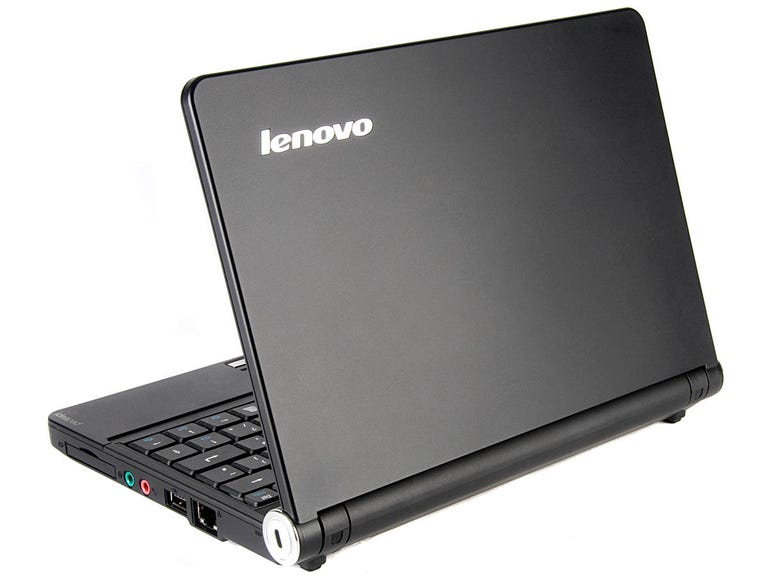 Why You Can Trust CNET
Why You Can Trust CNET Lenovo IdeaPad S10e review: Lenovo IdeaPad S10e
The 10-inch IdeaPad S10e doesn't really stand out from the netbook crowd, but it handles everyday tasks competently and boasts an attractive, understated finish. Its keyboard and battery life could be better, but the S10e is unusually compact and lightweight for a 10-inch netbook
Lenovo has plunged into the netbook market with not one but two new products -- the IdeaPad S9 and IdeaPad S10. It's also released special 'e' versions of both, aimed at students and teachers. The S10e, reviewed here, sports a 10-inch display, putting it in competition with the likes of the Asus Eee PC 1000HE.
The Good
The Bad
The Bottom Line
It's available now for approximately £250.
Design
The S10e has that familiar no-nonsense look we've come to expect from Lenovo machines. The understated, matte black chassis won't wow passers-by but, on the positive side, it doesn't lust for fingerprint smudges and grime like the majority of its glossy rivals.
The S10e is relatively compact and lightweight for a 10-inch netbook. It measures just 250mm by 28mm by 183mm and weighs 1.1kg, so it's a little easier to carry than the 1000HE, which measures 266mm by 191mm by 38mm, and weighs 1.4kg.
The upside of having a smaller chassis is that the bezel around the 10-inch display looks trim and stylish. The downside is that Lenovo has had to squeeze the keyboard into a smaller space. As a result, the keys are small and more tightly packed than on the 1000HE, which makes it difficult to type accurately. Likewise, the mouse trackpad and selector buttons are both very small and require a multitude of finger strokes to accomplish tasks that might otherwise require just one or two.
A quick look around the chassis reveals other compromises. Whereas most netbooks benefit from three USB ports, the S10e has just two. It does, however, have an Ethernet port, microphone and headphone ports, an SD memory card reader and -- unusually for this breed of machine -- an ExpressCard/34 slot.
Features
The S10e's specs are generic by netbook standards. It uses an Intel Atom N270 CPU and 1GB of RAM running atop an Intel 945GSE chipset. It offers absolutely nothing more or less than the majority of its rivals, but that's hardly surprising given the relative lack of imagination shown by most netbook designers.
Wireless capabilities are pretty standard, too. It has optional Bluetooth and 802.11b/g wireless, so you can get online at wireless hotspots. However, like most netbooks, it lacks integrated 3G, so you'll need to buy yourself a 3G USB dongle if you want to access the Internet while away from a hotspot.
The 10-inch display on the S10e looks good on first inspection, but closer analysis reveals several problems. Firstly, it's fairly glossy, so it's difficult to use it in direct sunlight or in rooms where the lighting isn't completely diffuse. Secondly, the resolution is fairly poor. It runs at 1,024x576 pixels, instead of the 1,024x600 pixels you get on most laptops. It's not an awful lot less, but you know you have a problem when even Windows XP pops up with status messages complaining about how low the resolution is.
Windows XP is the primary operating system on the S10e, but it also has a pre-Windows Linux GUI known as 'Lenovo QuickStart'. Hit the power button once, wait 5 seconds, and you're presented with a splash screen with icons representing a Web browser, music player, photo gallery, instant messenger and Skype chat.
The idea is sound -- QuickStart should let you access the most common computing functions in less time than it would take you to access them in Windows. In practice, however, QuickStart is fairly redundant. Launching the Web browser, for example, takes approximately 30 seconds, which is about the same amount of time it takes to boot into Windows XP.
Performance
The S10e's core performance pretty much matches every other netbook on the market. It struggles with high-bit-rate, high-definition video and other such demanding tasks, but is quick enough to carry out everyday tasks without you thinking you're on a machine you bought back in the '80s. It scored 1,385 in the PCMark05 benchmarking test, which is roughly what we expect for this type of device.
Battery life on the S10e is disappointing. It ships with a tiny 2,800mAh power cell, so it's no surprise that it achieved a mediocre 2 hours and 15 minutes in Battery Eater's Classic test. In contrast, the 1000HE achieved almost 6 hours in the same test.
Conclusion
It's hard to think of a good reason to buy the Lenovo IdeaPad S10e, as it doesn't stand out from its competitors and comes up short in the crucial area of battery life. If you can find the S10e for a cheap price, it may be worth considering, but otherwise the Asus Eee PC 1000HE is better.
Edited by Charles Kloet
